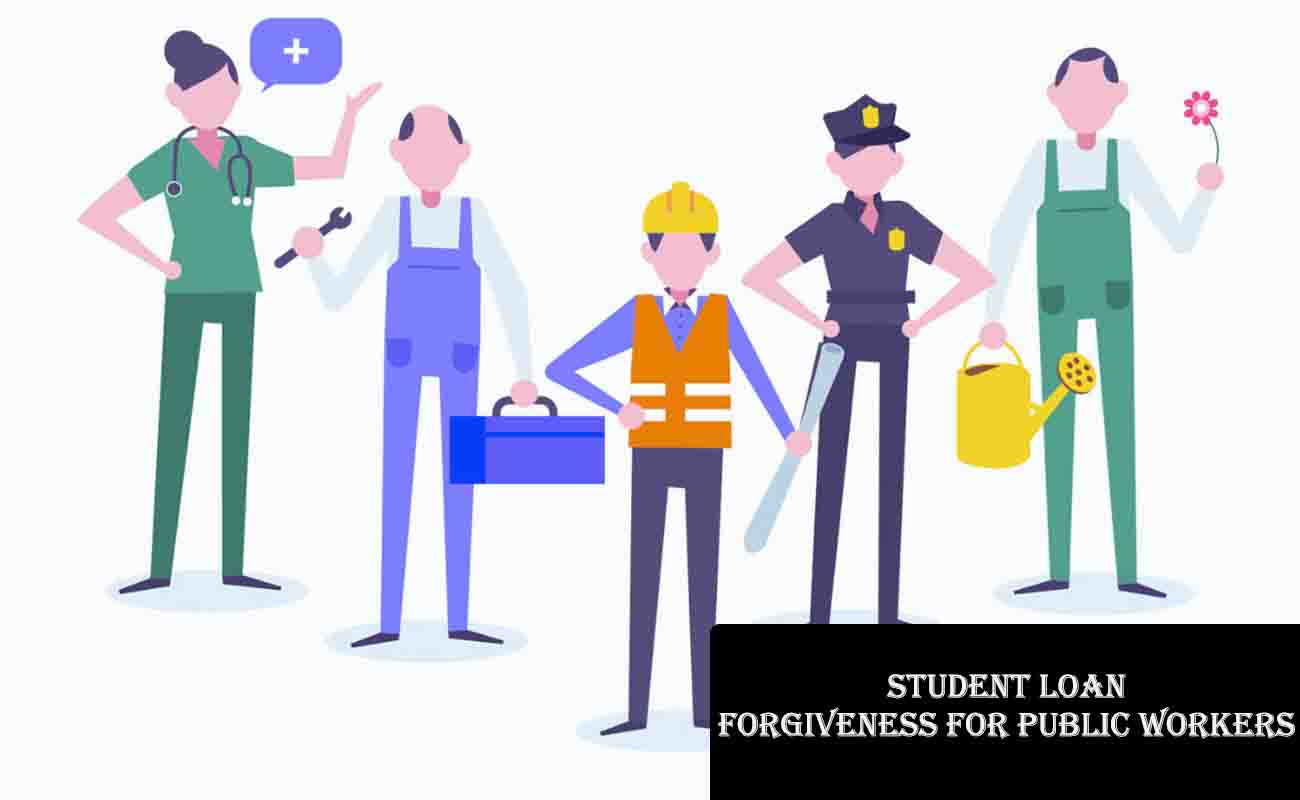I will share details about Student Loan Forgiveness for Public Workers in this post. If you’re like me, you’ve probably spent more time than you’d like thinking about student loans. They’re a heavy burden for so many of us, but there’s a ray of hope for those working in public service: the Public Service Loan Forgiveness (PSLF) program.

I’m here to break it down for you in simple terms, so you can understand what it is, who it’s for, how it works, and some important updates as of 2025. Whether you’re already in a public service role or considering one, this could be the key to unlocking financial freedom while doing work that matters.
Student loans can feel overwhelming, especially when you’re trying to build a career that makes a difference. But PSLF is designed to reward those of us who choose to serve our communities, whether through teaching, firefighting, working in nonprofits, or other public service roles.
After 10 years of dedicated service and consistent payments, your remaining federal student loans could be forgiven. It’s a game-changer, but it comes with some rules and requirements you need to understand. So, let’s dive in and make sense of it all.
Key Points
- What It Is: The Public Service Loan Forgiveness (PSLF) program may forgive your remaining federal student loan balance after 120 qualifying payments (10 years) while working full-time for a qualifying public service employer.
- Who Qualifies: You likely qualify if you have federal Direct Loans, are on an income-driven repayment plan, and work for a government or certain nonprofit organizations. Private loans don’t qualify.
- How It Works: Make 120 on-time payments, submit annual employment certifications, and apply for forgiveness. The forgiven amount is typically not taxable.
- Recent Changes: As of 2025, new rules might exclude some organizations from qualifying if they engage in activities deemed illegal, so you should verify your employer’s eligibility.
- Controversy: Recent changes have sparked concerns about potential political influences on the program, but it remains a valuable option for many public workers.
What is Student Loan Forgiveness for Public Workers?
Student Loan Forgiveness for Public Workers is officially known as the Public Service Loan Forgiveness (PSLF) program. It’s a federal initiative created in 2007 to encourage people to pursue careers in public service by offering a path to debt relief.
Here’s how it works: if you have federal student loans and work full-time for a qualifying employer, after making 120 qualifying monthly payments (that’s 10 years), the remaining balance on your loans can be forgiven. Yes, forgiven—meaning you won’t owe a dime on what’s left.
This program isn’t just about forgiveness; it’s about recognizing the value of public service. Teachers, nurses, social workers, government employees, and many others in nonprofit organizations can benefit. The amount forgiven isn’t considered taxable income, which is a huge plus. As of January 2025, the program has already helped over 1 million borrowers erase $78.46 billion in student debt, according to the U.S. Department of Education.
Who Qualifies for Student Loan Forgiveness for Public Workers?
To take advantage of PSLF, you need to meet a few key criteria. Let’s go through them step by step:
1. Your Loans Must Be Eligible
- You need to have federal Direct Loans or Direct Consolidation Loans. If you have other types of federal loans, like Federal Family Education Loan (FFEL) Program loans, you’ll need to consolidate them into a Direct Loan to be eligible.
- Private student loans don’t qualify, so if you have those, this program won’t apply.
2. You Must Be on a Qualifying Repayment Plan
- You need to be enrolled in a qualifying repayment plan, which includes:
- The Standard Repayment Plan
- Income-Driven Repayment (IDR) plans, such as:
- Income-Based Repayment (IBR)
- Pay As You Earn (PAYE)
- Revised Pay As You Earn (REPAYE)
- IDR plans are often recommended because they cap your monthly payments at a percentage of your income, making them more manageable if your salary isn’t high.
3. You Must Work for a Qualifying Employer
- You need to work full-time (typically 30+ hours per week) for a qualifying employer. Qualifying employers include:
- Government organizations at any level (federal, state, local, or tribal)
- Not-for-profit organizations that are tax-exempt under Section 501(c)(3) of the Internal Revenue Code (think charities, hospitals, and schools)
- Other not-for-profit organizations that provide public services must meet specific IRS criteria
- Not all nonprofits qualify. For example, political organizations or labor unions might not be eligible. You can use the PSLF Help Tool on the Federal Student Aid website (studentaid.gov) to check if your employer qualifies.
4. You Must Make 120 Qualifying Payments
- You need to make 120 monthly payments (10 years’ worth) while meeting all the above criteria.
- Payments must be made after October 1, 2007, and must be on time. Payments made during deferment or forbearance generally don’t count, except in specific cases (like during the COVID-19 payment pause from March 2020 to October 2023).
- Temporary changes, like the one-time IDR account adjustment in 2024, allowed more payments to count toward forgiveness, but those adjustments concluded in early 2025.
| Requirement | Details |
|---|---|
| Loan Type | Federal Direct Loans or Direct Consolidation Loans |
| Repayment Plan | Standard Repayment Plan or Income-Driven Repayment Plans (IBR, PAYE, REPAYE) |
| Employment | Full-time (30+ hours/week) for a government or qualifying nonprofit organization |
| Payments | 120 on-time payments after October 1, 2007, while employed by a qualifying employer |
How to Apply for Student Loan Forgiveness for Public Workers
Applying for PSLF isn’t overly complicated, but it does require you to stay organized. Here’s how to get started:
1. Verify Your Employer
- Use the PSLF Help Tool on the Federal Student Aid website (studentaid.gov) to confirm that your employer qualifies. Just enter your employer’s details, and it will tell you if they’re eligible.
2. Get on a Qualifying Repayment Plan
- Ensure you’re on a qualifying repayment plan. If you’re not already on an IDR plan, consider switching to one, as it can lower your monthly payments based on your income and family size.
3. Make Your Payments
- Keep making your loan payments on time. Each qualifying payment brings you closer to forgiveness. You can track your progress using the PSLF Help Tool or by checking your loan details on studentaid.gov.
4. Submit the Employment Certification Form (ECF)
- This is a critical step. You need to submit the Employment Certification Form to confirm that you’re working for a qualifying employer. You should do this annually or whenever you change jobs, even if you’re still with the same employer.
- The ECF helps track your progress toward the 120 payments. You can submit it through the PSLF Help Tool, which simplifies the process.
5. Apply for Forgiveness
- After making 120 qualifying payments, you can apply for forgiveness. Your loan servicer will guide you through this step. Once approved, the remaining balance on your loans will be forgiven.
Pro Tip: Don’t wait until you’ve made all 120 payments to start submitting the ECF. Many borrowers have been denied forgiveness because they didn’t submit the necessary forms or didn’t realize they needed to consolidate their loans. Stay proactive and track your progress regularly.
Recent Changes to Student Loan Forgiveness for Public Workers in 2025
As of 2025, there have been significant updates to the PSLF program, particularly regarding who qualifies as a public service employer. These changes stem from an executive order signed in March 2025, which aimed to “restore” the program by ensuring that only employers who truly serve the public interest can participate.
Key Changes
- Exclusion of Certain Employers: Organizations engaged in activities with a “substantial illegal purpose” are now ineligible for PSLF. Examples include:
- Aiding or abetting violations of federal immigration laws
- Supporting terrorism
- Engaging in child abuse (including certain medical procedures on children)
- Trafficking children
- A pattern of illegal discrimination
- A pattern of violating state tort laws (like trespassing or vandalism)
- Refined Definitions: In July 2025, the U.S. Department of Education concluded a negotiated rulemaking session where they made 15 substantive changes to the regulatory language. These changes aim to clarify what qualifies as a “public service” employer and ensure that only eligible organizations participate.
- Impact on Borrowers: If you work for a government agency or a traditional nonprofit (like a school, hospital, or public defender’s office), you’re likely still eligible. However, if you work for an organization that might be involved in activities deemed illegal under these new rules, you should verify your employer’s status using the PSLF Help Tool.
These changes have sparked some controversy, with concerns that they could be used to target certain organizations for political reasons. For example, some advocacy groups or organizations working with immigrants or transgender youth might face scrutiny. If you’re unsure about your employer’s eligibility, contact the Federal Student Aid information center at 1-888-303-7818 or check studentaid.gov.
| Change | Description | Impact on Borrowers |
|---|---|---|
| Employer Exclusions | Organizations with “substantial illegal purpose” (e.g., immigration violations, terrorism) are ineligible | Verify employer eligibility, especially for advocacy or niche nonprofits |
| Regulatory Updates | 15 changes to clarify qualifying employers | Stay updated on new rules via studentaid.gov |
| Rulemaking Process | Concluded July 2025, with draft rules pending public comment | Rules may evolve, so monitor Federal Register updates |
FAQs About Student Loan Forgiveness for Public Workers
Here are answers to some common questions about PSLF:
1. Do I have to work for the same employer for 10 years to qualify?
No, you don’t. You can work for different qualifying employers, as long as you’re employed by a qualifying organization when you make each of the 120 payments. Just submit the Employment Certification Form each time you change jobs.
2. What if I have private student loans? Can they be forgiven under PSLF?
Unfortunately, no. PSLF only applies to federal student loans. Private loans aren’t eligible, but you might explore other forgiveness options or refinancing for those.
3. Can I get forgiveness if I’m on an income-driven repayment plan?
Yes, IDR plans are qualifying plans for PSLF. Many people choose these plans because they can lower monthly payments based on income, making it easier to stick with the program for 10 years.
4. What happens if I miss a payment? Does that disqualify me?
Missed payments generally don’t count toward the 120 required for forgiveness. However, if you get back on track and continue making payments, you can still qualify as long as you eventually make 120 qualifying payments. Contact your loan servicer if you’re struggling.
5. Is the forgiven amount considered taxable income?
No, one of the best parts of PSLF is that the forgiven amount is not considered taxable income at the federal level. Check with a tax professional for any state or local tax implications.
Conclusion
Student Loan Forgiveness for Public Workers through the PSLF program is a powerful opportunity for those of us dedicated to making a difference in our communities. By understanding the requirements and staying informed about recent changes, you can work toward having your student loans forgiven after 10 years of service.
Regularly check your progress, ensure your employer qualifies, and submit the necessary forms on time. While the 2025 updates have added some complexity to who can qualify, the program’s core mission remains: rewarding those who choose careers that benefit society.
If you’re passionate about public service and have student loans, PSLF might be the financial relief you’ve been hoping for. Explore this option, talk to your loan servicer, and stay on track.
